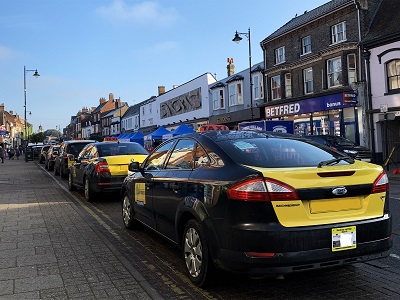“We have listened” – taxi proposals in response to survey findings
25 Feb 2022

Taxi drivers and customers will give their views on proposed licensing policy changes to wheelchair accessible vehicles (WAVs) and taxi zones in West Suffolk, next month.
West Suffolk Council has given notice of its intention to consult and is writing to taxi drivers and operators and groups representing the views of people with various disability or mobility issues, outlining proposals. It follows the outcomes of an independent survey, which has been undertaken alongside an in-depth study of taxis provision across West Suffolk during Autumn 2021.
The notice to consult is now subject to a formal 'call-in' period during which time other West Suffolk councillors can refer the proposal to its Overview and Scrutiny Committee which is the usual process for portfolio holder decisions. If that doesn’t happen, the council will launch a consultation on 23 March 2022, asking for views on three changes to its Hackney Carriage and Private Hire Conditions Policy Handbook.
The council’s existing WAV policy, which has been in place for a number of years, requires taxi drivers, to have a WAV when replacing their vehicle. Cabinet agreed to review this policy in September 2020 and in August last year, a month before the survey was due to launch, the council was presented with a petition and letter of concern by many taxi drivers.

During the Autumn 2021, the council carried out an in-depth study of taxi provision in West Suffolk, looking at WAV provision, the advantages and disadvantages of merging the taxi zones (West Suffolk currently has two zones, Zone A for the former Forest Heath and Zone B for the former St Edmundsbury) and the age of the fleet. Consideration was also given to future requirements of an environmentally friendly taxi fleet and the impact of COVID-19.
As part of this in-depth review, an independent survey of taxi drivers, operators wheelchair users, other disabled people and people who have mobility issues but would not identify themselves as being disabled, was carried out to understand people’s experience of WAVs.
The review has found that:
- WAVs do not meet the needs of all people with disability and mobility issues. As such, a mixed fleet of vehicles is required
- There is not a balanced provision of WAVs across the two taxi zones. However, there would likely be sufficient provision to meet current demand, if the zones were merged. A previous independent study in 2019 found there was a shortfall in zone A which could impact on availability
- That a large proportion of the fleet, including a third of WAVs, would need replacing in 2025 when the council’s vehicle age limit of 10 years comes into effect.
- That there is not sufficient public rapid charging infrastructure in place yet for the trade to switch over to electric vehicles and there is also a need for more advances to be made in relation to electric vehicles that can be a wheelchair accessible vehicle.
As a result, the Council proposes:
- To remove all wheelchair accessible vehicle (WAV) requirements for hackney carriage vehicle (HCV) licensees
- To merge the two taxi zones into one single zone
- To increase the maximum age of vehicle limit to 15 years old to allow more time for the trade to recover from the pandemic, and for advancements in EV charging technology, infrastructure and vehicle options. This new age limit would still mean those taxis emitting the highest carbon emissions would be removed from the roads in 2025.
The three proposals should not be considered in isolation to each other. The changes to the WAV requirement for instance cannot happen without the changes to the taxi zones. As such these proposals should be considered as one complete package of changes to benefit both the taxi trade and customers alike. The council cannot have different licensing policies for different parts of our district – so we cannot for instance address the concerns over the shortage of WAV provision with a policy that only applies to Mildenhall and Newmarket.
Becoming one taxi zone would allow the council to remove the WAV policy, monitor the situation and consider future changes as necessary. It would also mean that drivers, having taken a fare across from the former Forest Heath to the former St Edmundsbury or vice versa could actually then pick up fares going in the opposite direction.
There are some risks. Once made, a decision to become one zone cannot be reversed and taxis may flood areas that are seen as more profitable leaving other places short of vehicles. The council, however, believes that given the regular demand on taxis and the geographical spread of West Suffolk, the risk of drivers leaving their usual custom base to travel to another town in the hope of picking up more trade is low and it will work with the trade to mitigate any risks.
A West Suffolk Council spokesperson said: “The council recognises the significant contribution that taxis make to the local economy and the role they play in supporting leisure, education, and tourism. We also know that the needs and safety of the travelling public must be paramount within our policy. We have listened to both taxi customers and taxi drivers - and hope that we have found a pragmatic solution that they can get behind and work with us toward ensuring we have a thriving, safe, accessible and greener fleet.”
Posted in categories: press release, news
